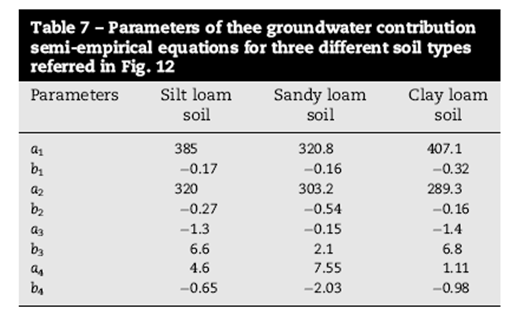The estimation of the groundwater contribution is required for computing the soil water balance in presence of high water tables that favour upward fluxes into the root zone, and the computation of deep percolation is needed when rainfall or irrigation are in excess to the soil water deficit, thus producing a downward flux through the bottom boundary of the root zone. These water balance terms are difficult to estimate accurately with water balance models but accurate computations are produced with deterministic soil water flux models, such as those using the Richards equation.
As an alternative to this approach, groundwater contribution into SoilW component can be estimated according to Liu et al. (2006). This approach consists in a semi-empirical method to estimate the capillary rise from a water table and the deep percolation through the bottom of the root zone and describes simple parametric functions to be used.
According to the average content of the soil profile of silt, clay and sand, the soil is classified into 3 categories, that are:
For each of these categories, a parameter set is assigned, as shown in the table below:

The assignation of the soil to one of these categories is automatic within the UNIMI.SoilW component.
Then, the following equations are applied:

where:
WC = critical water storage (mm)
a1, b1 = empirical parameters related to the soil typology and
Wd = water table depth (m).
For the calculation of steady water storage, the following equation is calculated:

where:
WS = steady water storage (mm)
a2, b2 = empirical parameters related to the soil typology and
Wd = water table depth (m).
Then, the critical water table depth is calculated with the following equation:

where:
DWC = critical water table depth (m)
a3, b3 = empirical parameters related to the soil typology and
ETm = potential evapotranspiration (mm d-1).
Next step, the potential groundwater contribution is calculated according to the following equation:

where:
Gmax = potential groundwater contribution (mm d-1)
Tr = crop transpiration (mm d-1)
Wd = water table depth (m).
DWC = critical water table depth (m) and
a4, b4 = empirical parameters related to the soil typology.
Finally, the actual groundwater contribution is calculated with this equation:

where:
G = actual groundwater contribution (mm d-1)
Gmax = potential groundwater contribution (mm d-1)
W = average water content of the rooted zone (mm)
WS = steady water storage (mm)
WC = critical water storage (mm)
Created with the Personal Edition of HelpNDoc: Easily create CHM Help documents